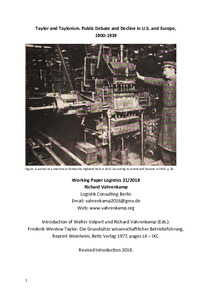Working paper
Taylor and Taylorism

Taylor and Taylorism
Public Debate and Decline in U.S. and Europe, 1900-1939
Abstract
Beyond the perspectives of labour science and industrial sociology, in which extensive deepening of the division of labour can be crystallized as an element of consensus under Taylorism, the concept of Taylorism found its way into general intellectual history. In 1954, the German-American management expert Drucker ranked scientific management among the most important contributions of the USA to Western culture. The dissemination of the concept of Taylorism in Western culture outlined here points to a high rank of Taylor's persons in the history of science and industry. The 3rd chapter reflects the economic and ideological conditions for the emergence of Taylorism at the turn of the century 1900 in the USA in the industrial environment of Philadelphia and Pennsylvania with its steel works and machine shops. It mentions two of the developments in economic history of USA: the monopolisation and the emergence of the new assembly-oriented industries. The industrial milieu of Philadelphia, where Taylor was to gain his first industrial experience, greatly favoured the development of his later ideas as is shown.
It also seems appropriate to look back and to reflect on Taylor's actual achievements and place them in the general history of industry. This is the subject of the 4th chapter. Here Taylor's efforts to put his ideas into practice and their acceptance by industry and the public are critically presented. Taylor must be taken at his word and the somewhat beautifully coloured picture that he draws of his personal efficiency and the success of his management system in his publication “The Principles of Scientific Management” must be corrected by confrontation with the traditional history of early Taylor. This procedure, as a by-product, throws away some material on the history of technocratic movements that has so far remained largely unknown.
It also seems appropriate to look back and to reflect on Taylor's actual achievements and place them in the general history of industry. This is the subject of the 4th chapter. Here Taylor's efforts to put his ideas into practice and their acceptance by industry and the public are critically presented. Taylor must be taken at his word and the somewhat beautifully coloured picture that he draws of his personal efficiency and the success of his management system in his publication “The Principles of Scientific Management” must be corrected by confrontation with the traditional history of early Taylor. This procedure, as a by-product, throws away some material on the history of technocratic movements that has so far remained largely unknown.
Citation
@unpublished{doi:10.17170/kobra-202304247882,
author={Vahrenkamp, Richard},
title={Taylor and Taylorism},
year={2023}
}
0500 Oax
0501 Text $btxt$2rdacontent
0502 Computermedien $bc$2rdacarrier
1100 2023$n2023
1500 1/eng
2050 ##0##http://hdl.handle.net/123456789/14638
3000 Vahrenkamp, Richard
4000 Taylor and Taylorism / Vahrenkamp, Richard
4030
4060 Online-Ressource
4085 ##0##=u http://nbn-resolving.de/http://hdl.handle.net/123456789/14638=x R
4204 \$dWorking paper
4170
5550 {{Philadelphia, Pa.}}
5550 {{Dodge}}
5550 {{Taylorismus}}
5550 {{Eisen- und Stahlindustrie}}
7136 ##0##http://hdl.handle.net/123456789/14638
<resource xsi:schemaLocation="http://datacite.org/schema/kernel-2.2 http://schema.datacite.org/meta/kernel-2.2/metadata.xsd"> 2023-04-28T11:32:29Z 2023-04-28T11:32:29Z 2023-04-20 doi:10.17170/kobra-202304247882 http://hdl.handle.net/123456789/14638 eng Attribution-NonCommercial-NoDerivatives 4.0 International http://creativecommons.org/licenses/by-nc-nd/4.0/ steel works effectiveness movement Braverman Dahrendorf Gass Philadelphia Pennsylvania Herbert Simon Copley Kanigel Krupp Midvale Carnegie steel industry steel mill quantification Breger conservation movement American society of mechanical engineers scientific management motion study film camera Henry Ford Bethlehem Steel high speed steel Tabor Manufacturing Highland Park Gantt Emerson Gilbreth Hoxie Dodge Link Belt punch card 300 Taylor and Taylorism Working paper Beyond the perspectives of labour science and industrial sociology, in which extensive deepening of the division of labour can be crystallized as an element of consensus under Taylorism, the concept of Taylorism found its way into general intellectual history. In 1954, the German-American management expert Drucker ranked scientific management among the most important contributions of the USA to Western culture. The dissemination of the concept of Taylorism in Western culture outlined here points to a high rank of Taylor's persons in the history of science and industry. The 3rd chapter reflects the economic and ideological conditions for the emergence of Taylorism at the turn of the century 1900 in the USA in the industrial environment of Philadelphia and Pennsylvania with its steel works and machine shops. It mentions two of the developments in economic history of USA: the monopolisation and the emergence of the new assembly-oriented industries. The industrial milieu of Philadelphia, where Taylor was to gain his first industrial experience, greatly favoured the development of his later ideas as is shown. It also seems appropriate to look back and to reflect on Taylor's actual achievements and place them in the general history of industry. This is the subject of the 4th chapter. Here Taylor's efforts to put his ideas into practice and their acceptance by industry and the public are critically presented. Taylor must be taken at his word and the somewhat beautifully coloured picture that he draws of his personal efficiency and the success of his management system in his publication “The Principles of Scientific Management” must be corrected by confrontation with the traditional history of early Taylor. This procedure, as a by-product, throws away some material on the history of technocratic movements that has so far remained largely unknown. open access Vahrenkamp, Richard 51 Seiten Kassel, Universität Kassel, Fachbereich Wirtschaftswissenschaften Philadelphia, Pa. Dodge Taylorismus Eisen- und Stahlindustrie Public Debate and Decline in U.S. and Europe, 1900-1939 publishedVersion Working Papers Logistics No. 21/2018 false </resource>
The following license files are associated with this item:
Except where otherwise noted, this item's license is described as Attribution-NonCommercial-NoDerivatives 4.0 International
Related items
Showing items related by title, author, creator and subject.
-
Electron Beam Melting of Metastable Austenitic Stainless Steel
Buch
Günther, Johannes (kassel university pressKassel, 2020)


